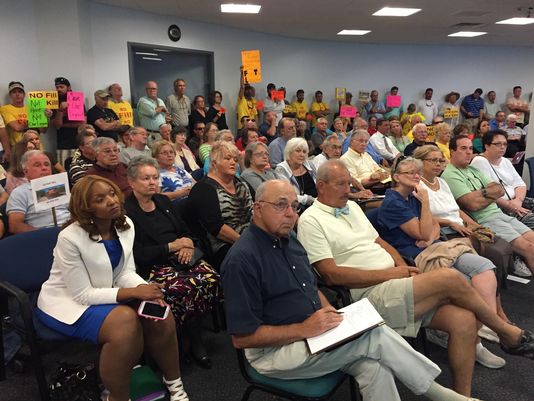Article Courtesy: floridatoday.com | By: Ted Lund | Originally published Aug 29, 2015 | Please click here for original article.
Above: A standing-room only crowd, like this one at the April 30 informational meeting held by the Canaveral Port Authority on its embattled commercial rail project, is expected as Brevard County Commissioners consider a resolution opposing the project. (Photo: tedlund.com)
Since learning that NASA intended to pull funding for two oceanic data buoys operated by the National Oceanic and Atmospheric Administration east of Port Canaveral next spring, Melbourne-based oceanographer Mitchell Roffer has been seeking out possible ways to keep the weather stations afloat and operating.
In addition to operating his ocean forecasting service for recreational and commercial fishermen, shipping lines and oil exploration companies, Roffer is a member of SECOORA, the South East Coastal Ocean Observing Association. The group provides technical advice and observations to informed decision makers and the public from North Carolina to the west coast of Florida.
“NASA originally funded the buoys to aid in the recovery of items for the shuttle program,” Roffer says. “But since then, boaters, fishermen and even cruise and cargo ships have come to depend on them for real-time wave and wind data that can’t be accurately predicted by models.”
And anglers with smaller boats depend on the buoys for safety.
“For many with small boats in Central Florida (including the greater Orlando area), checking the current data provided by the buoy is the “go-don’t go” decision, says John Durkee with the Florida Sport Fishing Association. “It’s not about if fish are biting, it’s all about safety. There is no other single source that provides real time data of the sea conditions.”
The two buoys in question are formally known as Station 41009 and Station 41010, and are 20 miles and 120 miles, respectively, east of Port Canaveral. They provide a wide range of real-time data, including wind direction, speed, gusts, wave height, dominant wave period and the average period between waves and their prevailing direction. Other data recorded and broadcast includes atmospheric pressure and tendency, air and water temperature and dew point.
“This is all critical information that recreational and commercial interests need to plan safe passage in and out of Port Canaveral as well as traversing the Gulf Stream to the Bahamas and back,” Roffer says. “Without them, it would be like fishing or boating blind — never knowing what types of conditions exist and would really be putting people in harm’s way unnecessarily.“
Since learning of NASA’s defunding and NOAA’s intent to take the stations offline, Roffer has been exploring a number of options to try to keep the weather buoys operational, including replacing them with public and private sources. He estimates the annual operating cost of the two stations would be about $120,000 per year.
Roffer reached out to Canaveral Port Authority Executive Director John Walsh, who responded Tuesday via an email obtained by FLORIDA TODAY that: “Weather is not the ports (sic) responsibility. Staff is not recommending Port Canaveral take this on as our issue.”
Port Commissioners disagreed with Walsh, however, during their monthly public meeting Wednesday after Roffer made an impassioned plea during the public comment period. Commissioners passed a motion to draft a letter to NOAA asking for continued funding for both buoys.
“This is a very positive gesture that the commissioners appreciate the critical health and safety nature of having the NOAA buoys in operation,” Roffer says.
Throughout the search, Roffer may have found another possible partner in keeping the buoys alive in District 2 Brevard County Commissioner Jim Barfield, who believes that the county and possibly state might make sense as partners to keep the buoys afloat.
“This is a safety issue not only for Brevard County residents, but the thousands of Central Floridians that use Port Canaveral to access the Atlantic Ocean for a variety of waterborne activities,” says Barfield, whose district encompasses Port Canaveral.
Barfield has set up a meeting with Roffer to discuss possible options for partially or fully funding the stations next week, saying, “I believe this should be a priority and I think that it is something that our governor would support.”
But the clock is ticking.
NOAA is planning on taking the buoys out of commission at some point next spring.
Commission to consider
anti-rail resolution
The Brevard County Commission will be considering a resolution proposed by Barfield at Thursday’s meeting at the Commission Chambers at the Viera Government Center, beginning at 5 p.m.
The resolution is written by Barfield with input from various stakeholders in the Cocoa Beach, Cape Canaveral and Merritt Island areas potentially most affected by Port Canaveral’s proposed commercial rail project.
“The public will have five minutes to speak in support or opposition of the rail project,” says outspoken Canaveral Port Authority critic and professional fishing guide, Alex Gorichky.
“This is a chance to let our elected officials — who are doing everything they can to help save and protect the Banana and Indian River lagoons — know how the public feels.”






